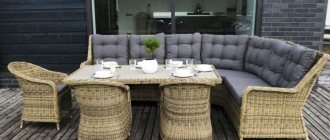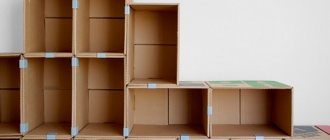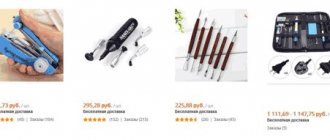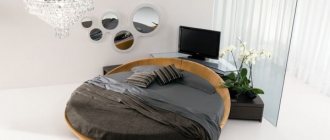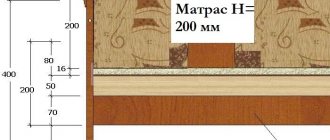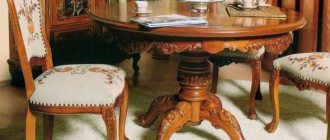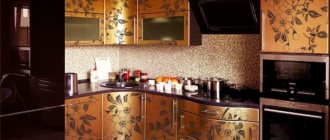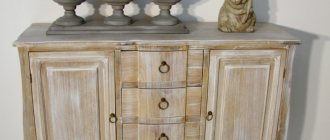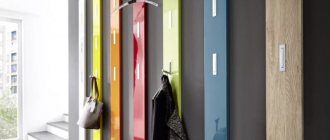0
35286
The product market offers a huge amount of upholstered furniture of different models and configurations in any price category. But often in the interior of a room you want to have an original product in an unusual design. Making upholstered furniture with your own hands is an entertaining process that will not only save money, but also implement individual ideas for the configuration, as well as the appearance of the product. So what is important to know when creating an exclusive piece of upholstered furniture?
Transformation mechanism for the “Tango” sofa
When preparing this article, I came across the fact that manufacturers come up with their own names for mechanisms of the same type in terms of properties. This causes confusion. This is the case with the “Tango” mechanism.
The “Click-clack (clack)” mechanism has similar properties. In fact, both mechanisms are similar to the “Book” already described above.
The main difference from the “Book” is the ability of the “Tango” (“Click-clack (clack)”) to take intermediate positions of the back of the sofa when unfolding.
In addition to full horizontal folding, the backrest can be in a half-lying, half-sitting position. This opportunity creates additional comfort for relaxation.
“Tango” sofas have a section for storing beds
Advantages: the mechanism allows you to fix the back of the sofa in several positions, “Tango” sofas are small in size, and when folded flat, the sofa creates a surface without unevenness or bumps.
Disadvantages: it is not possible to place the sofa tightly against the wall; when transforming, the backrest needs space to fold out.
Stages of assembling upholstered furniture
Purchasing filler
One of the most critical stages in the manufacture of upholstered furniture is the purchase of material, which will directly affect the quality of the final result. For more than 10 years, foam rubber or polyurethane has been used as a filler for the product, the thickness of which completely depends on the place where the material is used.
Choice of upholstery fabric
If you purchase upholstery fabric yourself, you should give preference to the most durable, practical option that meets the following criteria:
- Possibility of self-removal of stains;
- resistance to physical and mechanical stress;
- resistance to household chemicals.
Selection of base material
As the main material of the product, preference should be given to plywood or, in extreme cases, chipboard. All other materials are more fragile and unreliable for the use of such expensive products.
Creating a Sketch
Like any work, the creation of upholstered furniture begins with the development of a sketch, accurate drawings, and setting dimensions.
Creating a sketch is a labor-intensive, important stage, on the result of which almost the entire success of the work done will depend. Since every unaccounted millimeter will emerge during final assembly and upholstery of the structure.
When creating a schematic representation of the planned model, it is necessary to take into account the relevance of the selected assembly mechanisms, if any, ease of use, the modernity of the model, the number of fittings used to ensure the best performance.
Currently, thanks to technological progress, it is possible to create a schematic image in specially developed programs that independently take into account and make adjustments.
Sawing material
Sawing the material can be done in 2 ways:
- independent. Self-sawing is possible when creating the most basic components of a product, using which modern upholstered furniture with your own hands does not require figured cutting, additional large-sized elements, and so on;
- third party. Sawing the material using specialized equipment is performed to create smooth lines, precise cuts, cutting all parts from a large sheet, and so on. The use of specialized equipment to create the basis of modern upholstered furniture is, in some way, the key to proper assembly, and, accordingly, the entire product.
Material marking
After the final cutting of the material, it is necessary to make markings on the components of the product, which will help in the future to avoid the occurrence of curvature, inconsistency, and so on.
Fastening components
Upon completion of the preparatory work, it is necessary to begin the direct assembly of the parts, during which both self-tapping screws and additional fittings are used to ensure the movement of the components of the model.
Attaching foam rubber to the walls of the product
The inner foam rubber is attached to the walls of the product using special glue, which ensures the reliability and durability of the product. Often, it is not worth skimping on purchasing such glue, since additional reworking of the entire product will cost much more.
Fastening of foam rubber is carried out only after direct cutting of the components of the product and fitting. Also, when attaching the foam rubber, it is necessary to ensure softness in all connecting and transitional places. For example, such places could be: joints, side, and so on.
Making a case
Sewing a fabric cover is not always done in the traditional way. Over the past few years, furniture staplers have gained popularity; the quality of fastening staples is no worse than a solid cover.
By creating furniture with your own hands, everyone has the opportunity to test their strength as a designer-developer, process engineer, or assembler of upholstered furniture.
Using coating for furniture material
Modern technologies make it possible to veneer inexpensive materials by veneering, laminating, laminating and postforming. As a result, they become stronger and acquire a more presentable appearance, which makes them suitable for use as furniture facades.
Laminating
Laminating technology is used in the production of furniture boards. The facing material is textured paper. After gluing it to the chipboard, a protective coating is formed.
It is important to know: laminated panels are not intended for intensive use and do not tolerate high humidity.
Melamine coating, or artificial veneer
Melamine coating is the hot application of a paper layer and a film of melamine-formaldehyde resins onto a base made of MDF or chipboard. Artificial veneer imitates the texture of different materials. The durable coating has good water and wear resistance, is resistant to high temperatures, but it remains scratched by sharp objects and traces of aggressive chemicals. Melamine veneered boards are used in the production of countertops, kitchen furniture, drawer fronts and cabinets.
Lamination
Polymer resins are used for laminating fiberboard and chipboard. The thickness of the durable film ranges from 0.5 to 1.3 mm. The coating is created under high pressure at a temperature of about +200°C and acquires special strength. It can imitate wood and stone, smooth and corrugated surfaces.
Postforming
The technology is used in the production of parts with rounded edges. The coating is applied to MDF or chipboard boards. Its base is textured paper treated with plasticizers. When heated, the material becomes flexible and easily follows the shape of the panel. When cooling, the film retains its given configuration.
Postforming coatings are distinguished by such characteristics as strength, resistance to aggressive environments, light and heat resistance, and water resistance.
Types and classifications of sofas
Under one general name “sofa” are hidden a variety of types of this furniture. And corner ones, and books, and even round ones. To understand which sofa is suitable for an apartment, it is worth understanding the classification of this type of furniture. First of all, let's look at sofas by the type of how they fold out (or transform), that is, by the type of folding structure.
Sofas come in different types of transformation
Table. Types of mechanisms.
| View | Description |
| Sesame | Such a sofa can easily be turned into a full-fledged and quite spacious and comfortable bed, although only for one, and it will have a comfortable mattress resting on an orthopedic hard surface. It is perfect for decorating a nursery, a hall or another room. To unfold this version of the sofa, you first need to pull out the part hidden in its depths, and then raise the sleeping place itself. This is a proprietary development of Anderssen. |
| Junior | This is an excellent option for a small room, often placed in a nursery. It looks like an ordinary sofa, but when unfolded it turns into two beds, one per person. Between the sleeping sections there is a small seating area. This sofa can be folded out very simply - you need to pull out the sleeping places using special hinges. |
| Tango | This sofa resembles a variation of a click-clack book and is suitable for those who want to sleep together. It’s easy to unfold – you just need to lift it up a little and then lower the top back. It turns out to be a fairly spacious place to spend the night. The sofa has armrests, they can be positioned at the desired angle and made into a headrest. |
| Coupe | This sofa can easily be converted into an analogue bunk bed. It is the original development of one of the furniture companies. This is an excellent option for a nursery, as well as for those who often receive guests for several days. To unfold it, you need to lift the upper part of the structure up, fix the side for the upper place, install a ladder and raise the lower sleeping place located in the depths of the bed. |
| Accordion | This is a classic version, which is a kind of accordion of three elements - two halves of the back and seat. By unfolding it, you can get a spacious place that can accommodate up to 3 people. When folded, it will not take up much space, but it requires a lot of free space in front of it. |
| American folding bed | Easily foldable option. The “bed” is rolled up inside, and you just need to unroll it and you can get ready for bed. Moreover, such a place does not have any kinks or seams, which means it is very comfortable to sleep. Ideal for a guest room. |
| Breeze | To unfold such a piece of furniture, you need to roll out the sleeping section forward. It will not take up much space, but will provide sleeping places for two people. |
| New Roller | One of the simplest options. If you pull the back, a dream space rises from the depths of the sofa. There are no rough joints on it, sleeping is very comfortable and cozy. |
| Eurosophist | Easy to fold out comfortable sofa. You just need to pull out the laundry drawer and place part of the seat on top of it. The furniture takes up little space, and the joint between the halves of the sofa is almost invisible. |
| Transformer | Such sofas can be hidden for the day when they are not needed in a closet or table. And only at night take them out again and turn them into a sleeping place. |
Sofa book
Also, sofas can be divided into several types according to the type of design.
- Straight - a sofa with a flat seat and a flat back. Can be folded out. It is this type that book sofas belong to.
- Chair-bed. Compact and take up very little space when folded. Designed for one person's sleep.
- Angular. For a long time, such sofas were very fashionable. But they take up quite a lot of space. They have an angular shape and can be converted into a bed by folding out or pulling out the straight part of the sofa.
- Couch. A small-sized sofa that can easily be converted into a bed for one person just by moving the seat and lifting the lower part.
- Roll-out. This sofa unfolds by rolling part of it forward or to the side.
- Unfolding. To unfold such a sofa, part of it needs to be unfolded.
- Folding - a sofa that can be unfolded and turned into a place to sleep 1-2 people.
Sofa “Book-Finka”
Cushioned furniture? It's simple!
As you can see, the manufacture of this type of furniture is within the capabilities of an inexperienced home craftsman. It doesn’t matter where you live - upholstered furniture in Moscow is made in the same way as in a small village.
In the article we described models that do not require complex milling and polishing of parts.
Perhaps starting with a simple stool, you will become seriously interested, and over time you will master all the subtleties of this art. Leave your tips and comments below. Subscribe to our newsletter. Good luck to you and good luck to your family!
How to cover a sofa
For covers it is best to use non-woven material. The simplest option is to cover the modules with fabric with folds at the corners. However, this solution will not last long.
Cases with stitched corners are more reliable. We make it removable with a zipper, ties or buttons, or fasten it with a stapler directly to the frame. We sew at home or order from a master.
First, we divide the sofa into sectors. Keep in mind that after measuring, all pieces of fabric should be cut into rectangular pieces. The rule also applies to sofa elements with other shapes.
Then you need to cut out a blank from wallpaper or newspapers to compare them with the fitted modules. We make cuttings according to them. Don't forget about a seam allowance of 8 cm.
content .. 120 121 122 123 124 125 126 127 128 129 ..
71.
Technological process for manufacturing soft furniture elements
The technological process of wallpaper work depends on the design and shape of the product, the materials and semi-finished products used, the level of mechanization, the organization of production and the qualifications of workers. In this case, soft elements can be used: spring elements on the base frame; springless on a frame base; without a base frame.
A spring soft element is a design of springs that form soft elements, excluding their use as a base. Soft elements without bases are formed using a spring block or covering material (pillows, mattresses, mattresses, mattress pads).
Soft elements with covering material of animal and plant origin are sewn with various needles, pneumatic guns for stitching sides PP-2/25A, for attaching spring blocks PPS-22A, for attaching fabric to a wooden base PP-5A. In the manufacture of soft elements, spring blocks of continuous weaving are used on the base; made of double-cone springs connected by spirals at the base; without reason.
The technological scheme for manufacturing soft elements using a continuous weaving spring block consists of the following operations: 1) forming a rigid base; 2) attaching the caps to the middle of the frame; 3) installation and fastening of the spring block to the base; 4) alignment and final fastening of the spring block to the base; 5) covering the spring block with cover fabric and stitching it; 6) formation of flooring material and covering with covering fabric; 7) quilting the flooring and sides; forming a second flooring layer; 9) covering the soft element with facing fabric.
2) attaching the caps to the middle of the frame; 3) installation and fastening of the spring block to the base; 4) alignment and final fastening of the spring block to the base; 5) covering the spring block with cover fabric and stitching it; 6) formation of flooring material and covering with covering fabric; 7) quilting the flooring and sides; forming a second flooring layer; 9) covering the soft element with facing fabric.
In Fig. 228 shows a conveyor for putting a cover on a soft element blank. The diagram for forming a seat on a spring block is shown in Fig. 229.
Individual soft elements (mattress pillows, mattress pads, bolsters) are not tightly attached to the frames. Such soft elements can be spring or springless. In Fig. 230 shows a roller on springs of continuous weaving with a base - a wooden block.
Soft elements can be made without springs (Fig. 231). In these cases, softness is created by flooring material of animal or plant origin. The sequence of operations in the manufacture of such elements: 1) filling the cover with flooring material; 2) quilting the sides; 3) firmware of the mattress blank; 4) laying an additional layer of cotton wool; 5) putting on the facing cover and stitching it up.
With the advent of synthetic flooring materials (sponge rubber, foam rubber) in the production of upholstered furniture, and improvements in the design of materials and technology, mattresses began to be manufactured in the form of separate elements placed on a base.
Rice. 228. Conveyor for putting on a cover: 1 - preparation of a soft element; 2 - pressure conveyor; 3 — pressure plates; 4 — cover; 5 - feed conveyor drive
Rice. 229. Seat formation diagram: 1 - seat frame; 2 - spring block of continuous weaving; 3 - facing fabric; 4 - integumentary tissue; 5 - layer of cotton wool; 6 - foam rubber; 7 - trap for settling the spring block in height
rice. 230. Scheme for manufacturing a roller on continuous weaving springs: 1 - continuous weaving spring block; 2, 4 — integumentary tissue; 3 - layer of cotton wool; 5 - facing fabric; 6 - wooden shaft of the roller; 7 - wooden boss
Rice. 231. Scheme of the automatic cutting line for sheet and slab materials MRP-1: 1 - floor conveyor; 2, 7 — lifting tables; 3 - carriage; 4— CTMF machine; 5 - stacker conveyors; 6 - pusher
content .. 120 121 122 123 124 125 126 127 128 129 ..
Master class on creating a frameless model
This design is lightweight, portable, does not scratch the floor covering, and can be easily repaired if defects occur. For work you will need foam rubber and durable furniture fabric. The manufacturing process begins with drawing up a drawing. First you need to prepare the required materials and tools, namely:
- sewing machine, threads, needles;
- scissors, glue;
- measuring instruments, chalk;
- highly elastic polyurethane foam brand HR 3535, capable of withstanding mattress loads of up to 120 kg;
- flock, zippers.
Let's look at the master class step by step using the example of a folding sofa consisting of 4 pillows:
- From a standard sheet of HR 3535 foam rubber, the dimensions of which are 160x200x4 cm (length, width, height), we cut out the required size, for example, in this case, 160x90x4 is the base, 160x60x4 is the second layer (seat), 160x30x4 is the second layer (stand under the back), 160x50x4 – back. To form pillows for each of these components, you will need 6 sheets to get a sofa height of 50 cm.
- We form pillows from foam rubber, glue the sheets together, and cover them with lining fabric. This will allow them to maintain their shape and will also make them easier to install in the case.
- We sew a cover from flock. To do this, we make markings on the fabric corresponding to the dimensions of the pillows with an allowance of 1 cm, cut it into rectangles and strips, and sew them together. At the junction of the stripes and one of the rectangles we install a zipper.
- At the final stage, all that remains is to assemble all the parts of the sofa together. How the parts will be connected needs to be thought through at the planning stage. There are two main ways to attach elements. They can be sewn inside out, stitching a double strip over the joint.
Manufacturing of upholstered furniture elements
The process of manufacturing upholstered furniture is divided into 2 stages:
- Creating a frame. This process will not be difficult if you have carpentry skills.
- Connection of all structural elements with laying of filler and installation of upholstery for chairs and sofas.
The base can be rigid, flexible and elastic:
- Rigid bases include frames and boxes with end caps made of plywood or solid fiberboard.
- Flexible and elastic bases consist of a frame or box, on one side of which supporting structural elements are installed, allowing them to bend.
Working with individual parts begins with marking them on the material. It is necessary to check everything carefully and thoroughly, and only after that start cutting out the workpieces using a jigsaw or carpentry machine.
Important! If all the parts are made in accordance with the drawings, then the first fitting will show how clearly the elements fit together. If necessary, correct errors immediately by adjusting the elements until they fully match. In this case, do-it-yourself furniture at home will be made with high quality.
Corner sofa
Corner design
To make a corner sofa, it is not necessary to use complex joints, for example, tenon products, or expensive materials. For work, we suggest using the following material, the volume and quantity of which depends on the size:
- timber 30×50 mm;
- chipboard;
- Fiberboard;
- plywood, thickness 5 and 15 mm;
- self-tapping screws and wood screws;
- nails;
- synthetic winterizer, with a density of 140–170 g/day;
- batting;
- foam rubber, thickness 20 and 40 mm with a density of at least 30 kg/m3;
- glue for foam rubber and wood glue;
- foam crumbs;
- furniture fabric;
- lifting mechanism;
- furniture legs 5 cm high.
As for the tool, for work you will need:
- wood hacksaw;
- miter box;
- screwdriver;
- stapler;
- sewing machine;
- knife.
Configurations and sizes of corner sofa blocks
Each structural block is made of a frame, which is based on timber, chipboard and plywood. The internal space in blocks 1 and 2 can be used rationally by making removable covers. To support them, a 20x30 mm beam is fixed around the perimeter of the frame. It is installed below the top cut to the thickness of the cover plate. To make it easier to lift the lid, you can drill holes in it for your fingers.
Frame design block 1
Blocks 1 and 2 are identical in design. The only difference is their size. The first block is 100x60 cm in size, and the second is 60x60. It is the second block that will be located in the corner of the structure and connect the first and third blocks. As for the third block, you can make a drawer-seat in it. Due to this, the usable area of the sofa will increase. To do this, you can install a retractable or rotating mechanism.
The drawer will also be equipped with a chipboard lid. While assembling it is not difficult, difficulties may arise when making the legs. Why? When sliding the drawer into the body of the sofa, they will interfere. Therefore, instead of legs, it is necessary to increase the height of the front side of the drawer. When unfolding the corner sofa, it will serve as a support platform. To make the drawer easy to pull out, you can attach furniture wheels to the bottom.
Block 3
The cover for the third block (indicated in the diagram) can also be made removable. For example, you can fold bed linen inside.
The size of the seat cushion should be equal to the size of the drawer. Therefore, when the drawer is pulled out, the pillow is removed from the back and placed on it instead of the mattress.
Design of the backrest of a corner sofa
Now it's time to make the backrest for the corner sofa. The manufacturing process looks like this:
- Place 3 beams horizontally and, as in the illustration, connect them with vertical posts. The height of the back in our case will be 105 cm.
- The lower second beam will be located at a height of 25 cm. They will serve to fix the backrest to the sofa.
- The top beam will be used as the basis for fastening the sheathing and provide the necessary rigidity of the structure.
- The frame is sheathed on both sides with plywood 5 mm thick.
- To avoid snags and unevenness when laying upholstery fabric, sand all corners with sandpaper.
- Glue thin foam rubber onto the side and front surfaces, due to this the upholstery will be soft.
Finally, all that remains is to cover the entire sofa, including the backs, with the selected material.
Fastening the upholstery
Before doing this, take all the measurements, and then cut out the fabric with an allowance for the hem. You can fasten the material with a stapler. The mounting location should be on the invisible part of the panel end. Make sure that the fabric does not wrinkle at the corners. As for the manufacture of pillows for the back and seat, they can be made from foam rubber with a density of 140–170 g/day and a thickness of at least 10 cm. You will also need to sew a cover with a zipper. This will allow you to remove the cover and wash it if necessary.
Step by step creation of a sofa
Making upholstered furniture with your own hands at home is a rather complex and time-consuming process, especially creating a sofa. Therefore, before starting work, think through every detail of the design in detail. Pre-design each element on paper. The more detailed the sketch, the easier it will be to make the sofa.
Important! Basically, the sofa has a length of 1.9 m, a back height of 0.75-0.85 m.
Device and components
The main elements of the sofa include:
- Frame.
- Seat.
- Back.
- Legs.
- Armrests.
- Accessories - you can sew decorative pillows.
Important! The frame is the main component, and the performance characteristics of the sofa depend on how well it is made.
Materials and tools
To make a sofa you will need the following tools and materials:
- Wooden beam.
- Chipboard, fibreboard.
- Canvas plywood.
- Upholstery material (sintepon, foam rubber, batting).
- Decorative furniture fabric.
- Ruler, pencil.
- Furniture glue.
- Electric drill.
- Electric jigsaw.
- Nails, screws.
- Screwdriver.
- Hammer.
- Knife, scissors.
- Furniture stapler.
- Sewing machine.
Assembly technology:
- Based on the drawings, cut out the base for the future product. Cut out the plywood shape using an electric jigsaw. If the product has a complex shape, then make the base from several parts joined together.
Important! The easiest way to cut out the base is from panels or plywood sheets left over from old furniture.
- Attach vertical posts to the base, then horizontal partitions.
Important! Decide in advance on the height of the sofa. The lounge sofa can be made lower, and the kitchen sofa higher.
- Lay plywood on the frame of the product.
- Attach the plywood to the frame using furniture glue and self-tapping screws.
- After assembling the frame, begin installing the backrest. It should be proportionate to the base of the sofa. Assemble the backrest in the same way as assembling the frame.
Important! The upper and lower beams of the backrest should be 8-9 cm wide.
- Attach the back to the base using metal corners.
- Treat the frame with sandpaper, plus, if necessary, paint or varnish.
- Start making soft blanks: make 2 bases 20-30 cm thick from furniture fabric and foam rubber.
- Connect the bases using a furniture stapler or a detachable zipper.
Important! To prevent rapid wear of the foam rubber, wrap it in padding polyester.
- Attach the prepared soft pillows to the base of the sofa with Velcro strips.
We create furniture upholstery
Palette for choosing materials for upholstery
Before you start upholstering furniture, you need to decide on the material - leather or fabric. Financial capabilities also influence the choice. You should not choose leatherette - it will not last long. Remember the rules: furniture elements must be covered with fabric before you begin to assemble the structure; when cutting, you need to take into account hem allowances (about two centimeters); Before you start cutting the material, make blanks.
Drawing of a frameless sofa chair for self-production
Having made the necessary measurements, we calculate the required length and width of the material. To make the upholstery last a long time, choose dense fabrics - chenille, tapestry, jacquard. They are better suited for work. We lay out the blanks on the selected material, outline them with chalk, not forgetting about the allowances, and cut them out. In this way we make patterns for the back, armrests, and back wall. We sew it on a sewing machine and put it on furniture elements, then we assemble the entire structure. Cushions on the sofa are sewn in the same way.
Elements of cut parts for upholstery of furniture
Upholstered furniture for a doll's house
If there is a child in the family, then sooner or later the parents will be faced with the question of how to make upholstered furniture for dolls with their own hands. After all, every girl likes to play with a dollhouse.
Before starting work, you need to decide which doll the furniture will be made for - Barbie, Winx or something else.
Next, you need to resolve the issue of materials. Upholstered furniture here may not necessarily be soft.
Sofas, beds, armchairs, couches, banquettes, poufs can be made of wood, matchboxes, cardboard boxes, paper, cardboard, plastic, foam.
Let's look at how to make upholstered furniture for Barbie using a bed as an example. You will need:
We recommend reading:
- DIY ottoman: step-by-step instructions for beginners (photos of finished work)
How to make a cabinet with your own hands: step-by-step manufacturing instructions and tips on how to build a cabinet from A to Z (105 photos)
How to make a table with your own hands - 150 photos, drawings, diagrams and the best projects for making a table with your own hands
- foamed polyethylene or expanded polystyrene;
- duct tape;
- satin fabric;
- cotton;
- a piece of foam rubber;
- threads of matching colors, needle;
- decorative details (lace, braid).
Order of steps:
- Cut the polyethylene to the dimensions of the future bed. To do this, you need to first measure the doll's height.
- Cut out the headboard and footboard from it. Don't forget about the legs.
- Cover the base of the future bed and both headboards with satin fabric.
- Cut out a mattress and pillows from foam rubber.
- Sew a mattress pad, pillowcases, duvet cover and sheet from cotton. Decorate it all to your liking with lace or braid. You can also sew or knit a blanket.
In conclusion, we note that creating upholstered furniture yourself requires some effort. This is a rather labor-intensive process. It is much easier to make a toy analogue.
In any case, the main thing is to be patient and strictly follow the instructions. An important factor is having the necessary tools and materials at hand.
Why is it important to choose the right sofa transformation mechanism?
- The mechanism is one of the main structural components of the sofa, therefore the overall service life of the transformable sofa depends on its reliability.
- The mechanism affects the convenience and ease of converting the sofa into different positions.
- Depending on the transformation mechanism, different free spaces in the room will be required to bring the sofa into the desired positions.
- The shape of the sofa also depends on the type of transformation mechanism. After all, it is under it that the mechanism is hidden from our eyes.
Now let's get down to specifics. Next, I will present various mechanisms for transforming sofas and describe their positive and negative sides. Let's go!
DIY corner sofa for the kitchen
The standard set of furniture for arranging a dining area includes a table, a corner sofa and stools.
According to the step-by-step instructions, to make a corner sofa for the kitchen, you will need:
- Board made of birch, beech or pine 2 by 4 cm - 100 cm.
- Beam with a section of 4 by 4 cm, about 135 cm.
- The beam is 2.5 by 2.4 cm, about 365 cm.
- Beam 1.5 by 1.5 cm thick - 300 cm. For covering the back wall, a sheet of fiberboard.
- Plywood 0.8 - 1 cm thick for the bottom and sides.
- You also need 5 cm thick foam rubber or padding polyester.
- Upholstery fabric (microfiber, tapestry, leather, nubuck and others).
To make a corner sofa for the kitchen with your own hands, prepare:
- jigsaw
- carpenter's corner
- plane
- furniture stapler
- screwdriver
- Sander
- drill
- bit
- hacksaw
- pliers
- roulette
- hammer
You will also need: confirmations, screws 0.4 by 2 cm, 0.4 by 6 cm and 0.4 by 8 cm, bolts and 0.8 cm washers, dowels, legs, hinges. If you plan to make a folding sofa with your own hands, then according to the instructions, you need a special mechanism. The drawing of the sofa for the kitchen should indicate the calculated dimensions and dimensions. In this case, your kitchen corner will fit perfectly into the dimensions of the room.
The workpieces are sanded and leveled, and only then can they be marked and sawed. The average length of a corner sofa is 120 by 90 cm, the corner insert is 45 by 45 cm, and the back height is 85.5 cm.
First, according to the drawings, the main parts of the sofa from the kitchen corner are made - these are the sides. They are made from a thick sheet of plywood. The markings are made with a pencil, and then the part of the kitchen corner sofa is cut out along the lines with a jigsaw.
The next step is to make two frames from 4 by 4 centimeter beams for both sides of the sofa. Both frames should be in the form of parallelepipeds, which are then fixed to the sidewalls. The connections at the corners should look like a mustache and a spike, which are subsequently glued. The T and L shape connections should be at a 90 degree angle.
At the corners, the connections can be with through holes or hidden, go into half of the beam, and also have one, two, or three tenons. They are secured with dowels or corners with self-tapping screws.
The frame of the corner sofa for the kitchen is connected to the back and secured on the sides. When the base is ready, you can assemble the hinged seat covers. Seats can be solid or sectional.
How to make a wooden shelf with your own hands read more
Rectangular frames for seats are made from a block 2.5 by 2.5 centimeters thick. Then they are sewn up with centimeter plywood. The seats are cleaned and covered with a layer of stain and varnish. Then foam rubber is glued and the fabric is stuffed.
A piano loop is attached to the long part of the corner sofa seats. Fastening the hinged covers is done at the end of the work. The corner module is assembled in the same way. A frame is made from a 4 by 4 centimeter block. The profile should be triangular in shape and have sides at angles of 45 and 90 degrees. The module is covered with plywood.
The assembled two parts of the sofas and the corner module are sanded. Exposed wooden elements are covered with stain and, accordingly, three layers of varnish on top. All parts are placed on the sofa legs and fastened together. The connection takes place using screws to the frame support. There must be at least 8 legs.
Structural details are adjusted when adjusting the height of the legs. Marks are made in the places of future fastening. Holes for bolts with a diameter of 0.8 centimeters are drilled. Bolts and washers for them should have wide margins. There should be twice as many washers as there are bolts, so that one goes under the bolt and the other goes under the nut.
The upholstery fabric depends on the proximity of the sofa to the stove and sink. The surface should be easy to clean and not exposed to chemicals.
For a small-sized sofa, 5 cm foam rubber is suitable. For a semi-soft corner of a larger size, padding is taken from padding polyester. Foam rubber or padding polyester is glued to the back with glue. The fabric is cut out according to patterns and stapled to the back of the back, as well as at the junction of the back with the seat. The material is stretched and securely fastened at the corners. Then it is fixed around the entire perimeter.
Choosing materials to replace upholstery on upholstered furniture
The first step is to choose a material that will not only be of high quality and increased wear resistance, but will also meet modern aesthetic requirements, fit perfectly into any interior and become its real decoration.
It is not necessary to select only fabrics for upholstery of upholstered furniture; eco-leather, genuine leather, suede or excellent materials are also perfect for this.
Most often used for reupholstery, these include:
Flock. It acts as an alternative to velvet, with a certain content of cotton and synthetics, and is distinguished by the characteristics of reliability and attractiveness.
Courtesan. Teflon-coated flock, which ensures easy removal of stains and contaminants of any complexity, is characterized by strength and beauty.
Jacquard. An amazing material that can combine notes of classic and modernity thanks to the application of relief patterns of various styles to the base.
Tapestry. To make this textile, more than 10 threads of various shades are used, which allows you to recreate a rich color and highlight the pattern on the fabric.
Original ideas for decorating windows for the New Year- Salt lamp - do-it-yourself manufacturing technology, operating principle and selection tips
Grounds for warranty repair of equipment
Shinilla. Allows you to replace natural velor, differing from it with a synthetic base, which determines the availability of the material and the ease of its manufacture.
When reupholstering furniture, you need to pay attention to the condition of the upholstery backing; to replace it, you can use foam rubber, which differs in rigidity, which is marked, and it should be purchased in advance, replacing it along with the upholstery.
The selection of materials is carried out taking into account a harmonious combination with other furniture and interior items; a successful combination and a well-chosen stylistic solution will emphasize the originality of the decoration of any room.
Calculation of profit from production
By making one corner sofa according to our video course, you can earn from 13,500 rubles by selling it, for example, on Avito for 30,000 rubles. This is a competitive price, as it is lower than the store price.
If you are a beginner, it will take you about a week to make alone:
- 1 day to buy all materials and accessories according to the list;
- 1 day to saw the parts and assemble the frame from them;
- 1 day to foam the frame elements;
- 4 days to sew the patterns and cover the frames.
By making the second and subsequent sofas, the manufacturing time will be reduced by approximately half. It takes the author of the course about 4 days.
To calculate profit, enter your data and press Enter or Tab. Prices are indicated in rubles, but you can enter prices in your currency.
Mechanism for transforming the sofa “Italian folding bed”
This transformation mechanism belongs to the double-folding mechanisms, just like the American clamshell. A double-folding mechanism is a mechanism that is brought into working position in two steps.
The principle of operation of the mechanism
To unfold the Italian folding bed from the sofa to the bed, you need to pull the upper part of the back of the sofa towards you (usually the back has a special loop for this purpose).
- In the first step of unfolding, the back of the sofa, together with the pillows, tilts forward and then lies down and rests on the seat of the sofa.
- At the second stage, the inner part of the sofa structure rotates around its axis, this is reminiscent of the unwinding of a rolled mattress. After this reversal, the support legs are revealed; the previously hidden ones were hidden and folded inside the structure, and the resulting sleeping area of the sofa rests on them.
Due to reinforced springs, the mechanism can be folded and unfolded without significant effort.
Advantages of the Italian folding bed: this mechanism is the most reliable and durable of folding beds, this became possible thanks to the use of reinforced metal pipes in the frame of the mechanism, the sofa when folded has a compact size, when unfolding there is no need to remove the pillows from the seat of the sofa, Italian folding beds have the most a thick and comfortable mattress for sleeping; in addition, the frame uses slats and belts that create an orthopedic effect.
Disadvantages: lack of storage space for linen, high price
In terms of ease of use and orthopedic properties, this type of mechanism is most suitable for a sleeping sofa for daily use.
